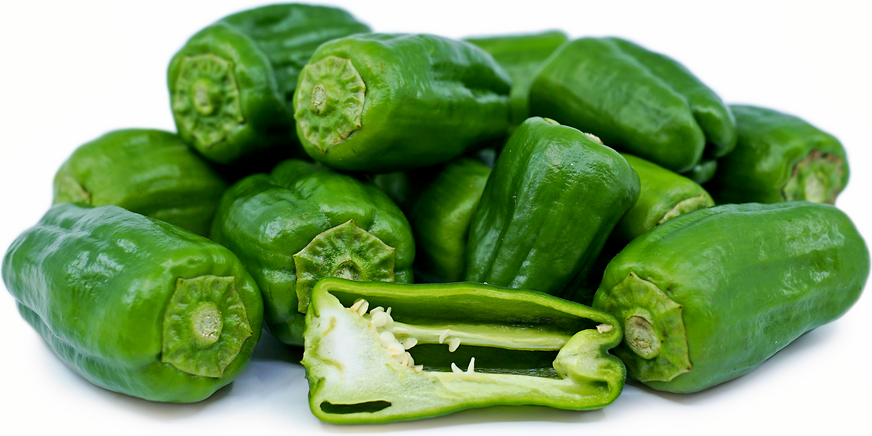


Green Japanese Bell Peppers
Estimated Inventory, lb : 0
Description/Taste
Japanese Green bell peppers are small in size, roughly one third the size of the American varieties, and have a rounded, square shape with multiple lobes that narrow and taper slightly towards the non-stem end. The skin is thin, glossy, smooth, and dark green, and the flesh is crunchy, juicy, and succulent. There is also a hollow, central cavity filled with pale green to white membranes and many small, flat, and circular cream-colored seeds. Japanese Green bell peppers are crisp with a sweet with a slightly bitter after taste.
Seasons/Availability
Japanese Green bell peppers are available in the spring through fall.
Current Facts
Japanese Green bell peppers, botanically classified as Capsicum annuum, are a small, semi-bitter variety that are members of the Solanaceae family. Also known as Piman in Japan, Japanese Green bell peppers are harvested before they reach full maturity and the word piman comes from the French word “pimant” meaning pepper. Japanese Green bell peppers are favored by chefs and home cooks in Japan for their crisp and pungent flavor and are commonly used in stir-fries, for stuffing, and as a grilled side dish.
Nutritional Value
Japanese Green bell peppers are an excellent source of vitamin C and also contain vitamin A, iron, fiber, and potassium.
Applications
Japanese Green bell peppers are best suited for both raw and cooked applications such as grilling, stuffing, baking, sautéing, and frying. They can be chopped and used raw in green salads, layered on sandwiches, used as a pizza topping, or sliced and consumed as a stand-alone snack. The peppers can also be stuffed with meats, grains, and seasonings, mixed into stir-fries or sautéed with other cooked vegetables. In Japan, the small bell pepper or piman is used mostly in grilled or deep-fried preparations, often dipped in tempura and then fried. Japanese Green bell peppers pair well with eggplant, carrots, bamboo shoots, broccoli, mushrooms, onions, shallots, garlic, ginger, meats such as ground pork, beef, or poultry, eggs, sake, red miso, sesame oil, mirin, sesame seeds, panko, katsuobushi, rice, and noodles. The peppers will keep up to one week when stored in the crisper drawer of the refrigerator.
Ethnic/Cultural Info
Green Japanese bell peppers are favored by many adults in Asia, but they have also become known as one of the more difficult vegetables for children to enjoy due to their bitter flavor. Children across the world have varying likes and dislikes when it comes to vegetables and flavors, and these distinctions between cultures are depicted in the movie Inside Out from Disney Pixar. In the United States, there is a scene where the main character must eat broccoli at the dinner table despite her distaste for the vegetable. In Japan, the broccoli was substituted for green bell peppers as the pepper is more disliked by children in Japan and would allow the audience to relate more to the main character.
Geography/History
Capsicum annuum is native to tropical America and was introduced to the rest of the world via explorers and trade routes. Japanese Green bell peppers were introduced to Japan in the nineteenth century and were mainly grown as a decorative plant. The popularity of bell peppers as food increased following World War II after an influx of American products were introduced to the island country. Today Japanese Green bell peppers are mainly grown in the Miyazaki prefecture and are available at supermarkets and local markets in Asia, Europe, and select regions in the United States.
Recipe Ideas
Recipes that include Green Japanese Bell Peppers. One




